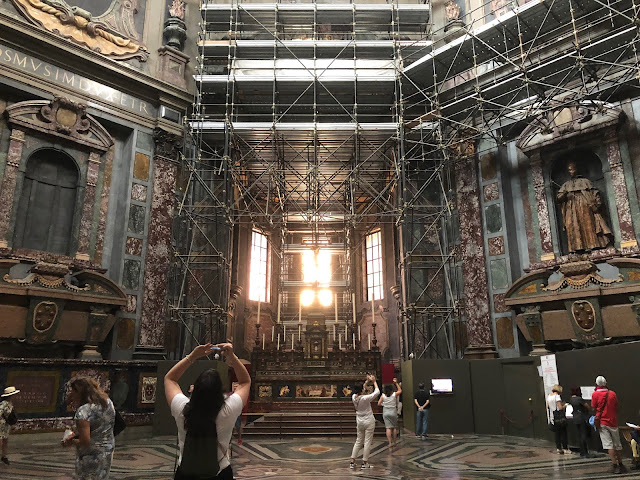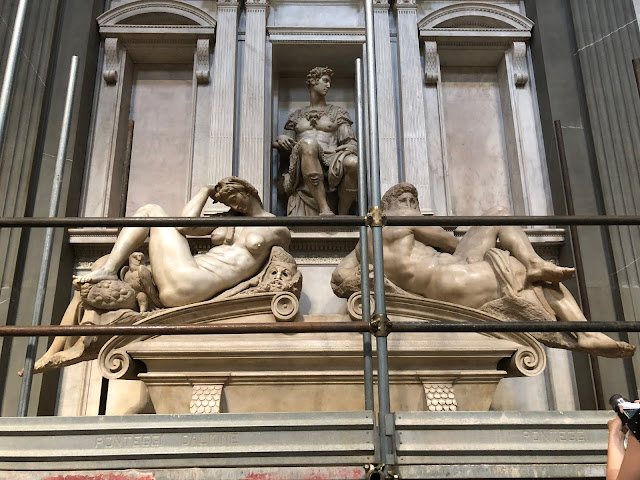【フィレンツェ】メディチ家礼拝堂 Firenze - Cappelle Medicee
サン・ロレンツォ教会の建物と併設して、メディチ家のための礼拝堂が建てられている。
その一つは君主の礼拝堂と呼ばれている施設で、メディチ家の傍系で建築家でもあったジョバンニ・デ・メディチによって1602年に建設が始められた。
しかしその後長い間建設は中断されて、メディチ家の最後の後継者アンナ・マリア・ルイーザ・デ・メディチの時代になっても、まだ完成には至らなかったという。
訪れた時は、ちょうど改修工事が行われていた。
A chapel for the Medici family is built alongside the San Lorenzo church building.
One of them is the monarch's chapel, which was built in 1602 by Giovanni de Medici, a sideline of the Medici family and an architect.
However, construction was suspended for a long time after that, and even in the era of Anna Maria Luisa de Medici, the last successor of the Medici family, it was not completed yet.
When I visited, the renovation work was just underway.
中央のドームの天井には、19世紀になってから描かれた、天地の創造などの物語の巨大な天井画がある。
アンナ・マリア・ルイーザ・デ・メディチは、メディチ家の所有する芸術品などの財産が国外に流出することを防ぐための法律を設定した人物。
そのおかげで、現在に至るまでフィレンツェには多くの芸術品が残り、この芸術の都としての地位を誇っている。
On the ceiling of the central dome, there is a huge ceiling painting of a story such as the creation of heaven and earth, which was drawn in the 19th century.
Anna Maria Luisa de Medici is the person who set the law to prevent the Medici family's property, such as works of art, from leaking abroad.
Thanks to that, many works of art remain in Florence to this day, and it boasts its position as the city of art.
君主の礼拝堂とは別に、サン・ロレンツォ教会の右奥に新聖具室と呼ばれる部屋があり、ここにミケランジェロの制作した彫像が展示されている。
1520年にメディチ家出身のレオ10世は、ミケランジェロにこの礼拝堂の制作を依頼した。
依頼の対象は、彫像だけでなく部屋全体の設計も含まれていた。この礼拝堂には、彫刻家としてのミケランジェロだけでなく、建築も含めた、ルネサンスの万能人としての才能が遺憾なく発揮されている。
Apart from the chapel of the monarch, there is a room called the New Sacristy on the far right of the church of San Lorenzo, where the statues made by Michelangelo are displayed.
In 1520, Pope Leo X, from the Medici family, asked Michelangelo to build the chapel.
The request included not only the statue but also the design of the entire room. In this chapel, not only Michelangelo as a sculptor, but also the talent as a Renaissance all-rounder, including architecture, is unfortunately demonstrated.
この礼拝堂に祀られているのは、豪華王ロレンツォ・デ・メディチの息子のジュリアーノと、その子のロレンツォの2人。
ロレンツォは、人間の主な活動である思索と行動のうち、思索を象徴する彫像で、一方のロレンツォは行動を象徴する彫像で表現されている。
ロレンツォは、戦いのための装いをしているが、左手を頬につけて何かの思いに耽っている。
The chapel is enshrined by Giuliano, the son of the gorgeous King Lorenzo de'Medici, and Lorenzo, the son.
Lorenzo is a statue that symbolizes meditation among the main activities of human beings, meditation and action, while Lorenzo is represented by a statue that symbolizes action.
Lorenzo is dressed for battle, but with his left hand on his cheek, he is indulged in something.
ロレンツォ像の下のには、黄昏と曙を象徴する2人の人物像が置かれている。
左側の黄昏は、やや年老いた男性の姿をしている。
Below the Lorenzo statue are two figures that symbolize twilight and dawn.
The twilight on the left looks like a slightly older man.
一方の右側には、今まさに目を覚ましたような女性の姿をした曙の像がある。
On the right side, there is a statue of dawn who looks like a woman who has just awakened.
そのロレンツォの反対側に、その父のジュリアーノの墓碑がある。
On the other side of Lorenzo is the tombstone of his father Giuliano.
行動を象徴するジュリアーノ像は、何かの決断を終えて、今にも行動に移ろうとしている。
その下には、昼と夜を表す、2つの彫像が置かれている。
ミケランジェロは、この2つの彫像の表情が実際のジュリアーノやロレンツォに似ていないことを知人に咎めらて、”そんなことは500年後は誰も気にしないさ。”と答えたと言われている。
ミケランジェロは、若い頃には豪華王ロレンツォに大変可愛がられてメディチ家の恩恵を多分に受けていたが、その後メディチ家が追放されてフィレンツェに共和制が実現すると、その象徴とも言えるダヴィデ像を制作したり、軍事技術者として共和制維持に協力した。
やがてメディチ家が再び権力を取り戻し、ミケランジェロも再びメディチ家からの依頼を受けざるを得なくなったが、その胸中は複雑だったに違いない。
この新聖具室の彫像群のテーマには、彼が若い頃に影響された新プラトン主義思想が色濃く反映されていると言われている。
おそらくミケランジェロは、特定の個人の彫像を作るのではなく、自らが表現したい人物像を作り上げたかったのだろう。
最初の計画では、ここには豪華王ロレンツォと、その弟でパッティ家の陰謀で殺害されたジュリアーノの墓碑も作られる予定だった。
しかし、新たにメディチ家出身の教皇クレメンス4世にシスティーナ礼拝堂に最後の審判を描くように依頼されたミケランジェロは、1543年にフィレンツェを離れてローマに向かった。
ミケランジェロは、その後2度とフィレンツェには戻らず、1564年にローマの地で88年の生涯を終えた。
もしもミケランジェロが再びフィレンツェに戻り、その残りの2つの像が作られていたとしたら、それらは一体どんなものであったのだろうか。
The statue of Giuliano, which symbolizes action, has made some decisions and is about to take action.
Below that are two statues representing day and night.
Michelangelo is said to have accused his acquaintances of the fact that the facial expressions of these two statues did not resemble the actual Giuliano and Lorenzo, and said, "No one cares about that in 500 years." ..
Michelangelo was very much loved by the gorgeous king Lorenzo when he was young and probably benefited from the Medici family, but when the Medici family was expelled and a republic was realized in Florence, he created the statue of David, which can be said to be a symbol of it. And helped maintain the republic as a military engineer.
Eventually the Medici regained power and Michelangelo was forced to accept a request from the Medici again, but his heart must have been complicated.
It is said that the theme of the statues in the New Sacristy strongly reflects the Neoplatonist ideas that influenced him when he was young.
Perhaps Michelangelo wanted to create the image of the person he wanted to express, rather than creating a statue of a particular individual.
The first plan was to build a tombstone here for the gorgeous King Lorenzo and his younger brother Giuliano, who was killed in a plot by the Patty family.
However, Michelangelo, who was newly asked by Pope Clement IV from the Medici family to draw the Last Judgment in the Sistine Chapel, left Florence in 1543 for Rome.
Michelangelo never returned to Florence and ended his 88-year life in Rome in 1564.
If Michelangelo had returned to Florence and the other two statues had been made, what would they be?
(Translated by Google Translate)










コメント
コメントを投稿